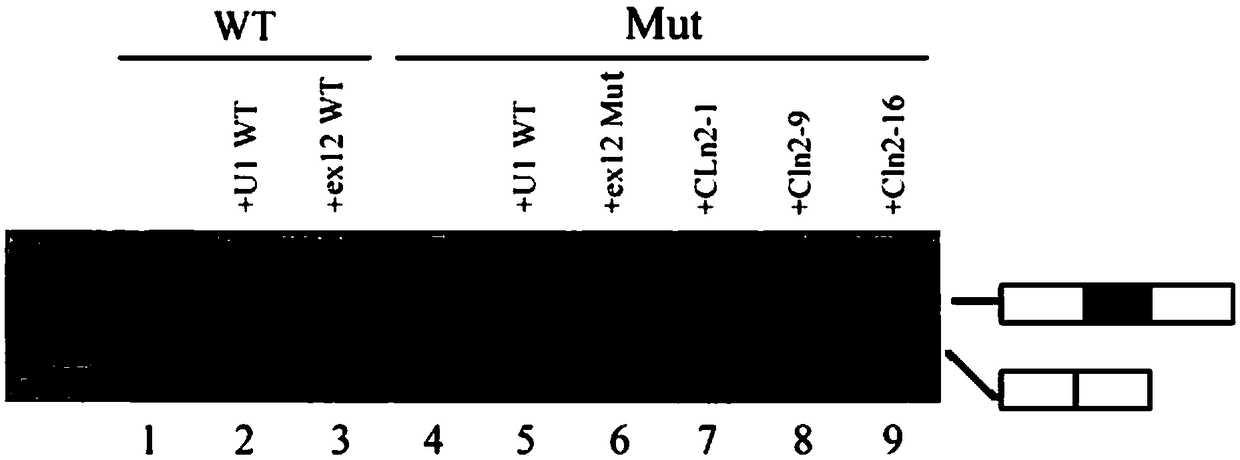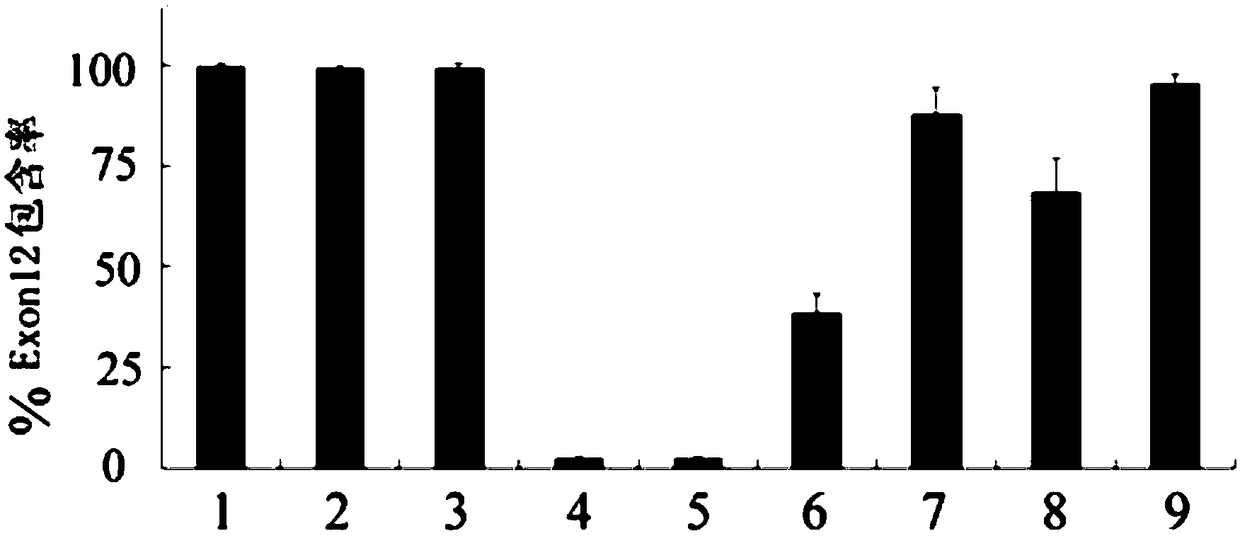U1-snRNA for repairing TPP1 gene Pre-mRNA aberrant splicing and application of U1-snRNA
A gene splicing, u1-snrna technology, applied in DNA/RNA fragments, gene therapy, genetic engineering and other directions, can solve the problems of difficult, undiscovered, and high repair efficiency of abnormal splicing, so as to make up for the lack of treatment methods and improve splicing. Repair efficiency and specificity
- Summary
- Abstract
- Description
- Claims
- Application Information
AI Technical Summary
Problems solved by technology
Method used
Image
Examples
Embodiment 1
[0038] An embodiment of the U1-snRNA single-stranded molecule of the present invention targets the position downstream of the splice donor site of exon 12 of the TPP1 gene, and the DNA base sequence corresponding to the 165bp single-stranded molecule is such as ex12Mut, Cln2- 1. As shown in Cln2-9 or Cln2-16, wherein, the underline shows the splice donor site with the TPP1 gene Exon12 or the intron sequence downstream of the splice donor site (as shown in SEQ ID NO.19, which includes the Exon12 splice donor site ATA is a sequence complementary to the bases on the wild-type TPP1 gene, so as to facilitate the transcription initiation of U1-snRNA. The transcribed U1-snRNA single-stranded molecules, for example, U1-snRNA Cln2-16 compared with SEQ ID NO.1, just replace T with U; correspondingly, U1-snRNA ex12 Mut, Cln2-9, Cln2- Compared with the RNA sequence of 16 and SEQ ID NO.2-4, just replace T with U.
[0039] ex12Mut:ATA ACTTATATC GCAGGGGAGATACCATGATCACGAAGGTGGTTTTTCCCAGGGC...
Embodiment 2
[0047] Example 2 The method for constructing targeted U1-snRNA expression vector
[0048] The U1-snRNA fragment was amplified using human genomic DNA as a template, and 641 bp of human U1-snRNA was amplified by PCR with NEB Q5 high-fidelity enzyme, in which 164 bp was the expression sequence of U1-snRNA marked underlined. U1-snRNA fragment amplification primer sequence is:
[0049] F: 5'-TTTGGATCCGACCAGCTTCTTTGGGAGAGAA-3' (SEQ ID NO.6);
[0050] R: 5'-TTTAAGCTTTTCCAAAAAACACCAACCAAGACACAAACCA-3' (SEQ ID NO. 7).
[0051] The human U1-snRNA gene sequence is as shown in SEQ ID NO.5, wherein the first underline is the U1 promoter sequence, the second underline is the U1-snRNA expression sequence, and the third underline is the U1 transcription terminator sequence:
[0052] CTAAGGACCAGCTTCTTTGGGAGAGAACAGACGCAGGGGCGGGAGGGAAAAAGGGAGAGGCAGACGTCACTTCCTCTTGGC GACTCTGGCAGCAGATTGGTCGGTTGAGTGGCAGAAAGGCAGACGGGGACTGGGCAAGGCACT GTCGGTGACATCACGGACAGGGCGACTTCTATGTAGATGAGGCAGCGCAGAGGCTGCTGC...
Embodiment 3
[0054] Example 3 Method for preparing targeted U1-snRNA by in vitro transcription
[0055] U1-snRNA in vitro transcription kit containing T7 RNA polymerase from Beijing Biolab Technology Co., Ltd. was used for in vitro transcription preparation.
[0056] a. Preparation of DNA template.
[0057] The U1-snRNA fragment of Example 1 was inserted between the BamHI and HindIII restriction sites of the pcDNA3.1(-) vector, used as a template for in vitro transcription, and the vector was linearized with BglII endonuclease. There is a T7 promoter upstream of the vector pcDNA3.1(-)-U1-snRNA fragment, which can be used for in vitro transcription.
[0058] b. In vitro transcription reaction.
[0059] In an RNase-free plastic centrifuge tube, add the following components in sequence at room temperature: 2 μg of DNA template (i.e., the vector pcDNA3.1(-)-U1-snRNA fragment obtained in step a), 25 μl of transcription premix (2 ×T7), 2μl T7 RNA polymerase, add RNase-free water to 50μl. Inc...
PUM
 Login to View More
Login to View More Abstract
Description
Claims
Application Information
 Login to View More
Login to View More - R&D
- Intellectual Property
- Life Sciences
- Materials
- Tech Scout
- Unparalleled Data Quality
- Higher Quality Content
- 60% Fewer Hallucinations
Browse by: Latest US Patents, China's latest patents, Technical Efficacy Thesaurus, Application Domain, Technology Topic, Popular Technical Reports.
© 2025 PatSnap. All rights reserved.Legal|Privacy policy|Modern Slavery Act Transparency Statement|Sitemap|About US| Contact US: help@patsnap.com



